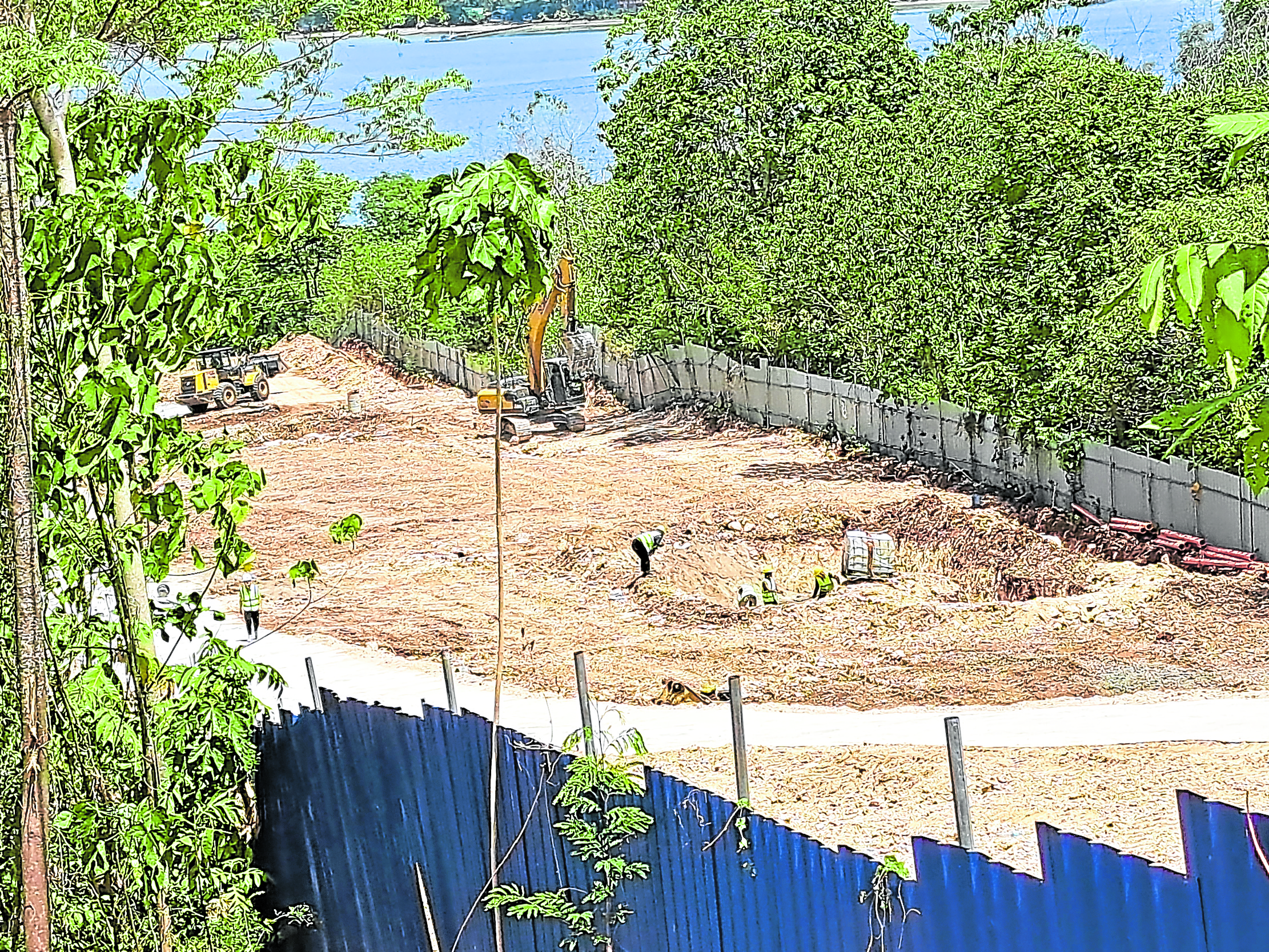Work on Samal-Davao bridge to begin soon, says DPWH

BUSY Site preparation activities continue at Barangay Limao in the Island Garden City of Samal for the landing site of the almost 4-kilometer bridge that will connect Davao City and Samal Island. —BONG SARMIENTO
ISLAND GARDEN CITY OF SAMAL — Despite opposition by environmentalists and affected property owners, the construction of the China-funded P23-billion bridge that will connect this island with Davao City is starting soon, officials of the Department of Public Works and Highways (DPWH) told reporters on Monday.
At Barangay Limao, where the bridge’s landing site will rise on the Samal Island side, at least 85 trees have been felled in preparation for the start of full blast civil engineering works likely to begin “by the last week of April or first week of May,” said engineer Joweto Tulaylay, project manager of the Samal Island-Davao City Connector (SIDC) project.
READ: Davao-Samal bridge hounded by land, env’t impact issues
“We will start with the onshore construction of the foundation of the bridge,” Tulaylay said at the DPWH Davao region office in Davao City.
At least 200 trees will be cut down in Davao City, on the bridge’s landing site in Barangay Hizon, where expropriation proceedings are still ongoing with commercial and residential land property owners affected by the project, he said.
Tulaylay said the project contractor, the Chinese government-owned China Bridge and Road Corp. (CBRC), has started clearing some of the sites acquired by the government on both ends of the bridge.
Compensating tree loss
Dean Ortiz, DPWH spokesperson in the region, said they had forged an agreement with the Department of Environment and Natural Resources (DENR) that 100 trees would be planted for every tree felled for the project.
Once the bridge is completed, it will reduce travel time to just five minutes, from 25 to 20 minutes by boat, excluding the waiting time aboard the roll-on, roll-off (Ro-Ro), which could take more than an hour.
READ: Port project on Samal Island ‘destroyed’ corals
“The bridge would definitely further boost the tourism and economy of Samal Island, and, at the same time, allow residents there easy access to government services or their work in the city,” Ortiz said.
Tulaylay called the Davao-Samal bridge a “complex project,” referring to the offshore works that environmentalists warned could destroy a rich coral reef called “Paradise Reef” on the Samal Island side.
Paradise Reef, measuring 300 meters long and 50 meters wide, hosts 79 species of hard corals, 26 species of soft corals and at least 100 species of reef fish, according to a study commissioned by the Paradise Island Park and Beach Resort, a property beside the bridge’s landing site on Samal Island, whose owners opposed the current alignment of the bridge.
Impact on corals
Julian Rodriguez, Paradise Island Resort manager, said they were not opposed to the construction of the bridge. “What we are opposing is the current alignment on the island because the construction would destroy the corals that have been around for hundreds of years already,” he said.
The coral reef system is just a few meters from the shores of the resort, clearly visible during low tide.
Marine biologist Filipina Sotto, who conducted a study commissioned by the Lucas-Rodriguez family in 2019, said the government’s chosen landing site had a healthy coral population.
It has a live coral coverage (LCC) of 36.3 percent, much better than the other rejected site proposed in 2016 by Japan’s Ministry of Economy, Trade and Industry, which has an LCC of 7.8 percent, the study showed.
Another volunteer marine biologist, John Michael Lacson, described Paradise Island as a “precious coral garden with significant importance to the marine biodiversity around Samal Island” and recommended rerouting the bridge to save the reef ecosystem.
Refuting their claim, however, Tulaylay said the DENR certified that the corals near the bridge’s landing site were “in poor condition,” and not as healthy as the scientists claimed.
Minimizing impact
The bridge’s landing site is part of the property owned by the Lucas-Rodriguez family. In January 2023, a writ of possession was issued by a local court, which allowed the DPWH to utilize the land where the bridge would land.
Rodriguez said their lawyers filed last year an appeal before the Supreme Court to issue a restraining order against the bridge’s construction based on its current alignment.
Tulaylay said they would minimize the impact of the bridge’s construction on the marine ecosystem at Paradise Reef by using a crane to lift materials in shallow offshore waters.
“If we use barges to bring in construction materials at the shallow portion, there would be huge destruction to the seabed,” he said.
According to the project’s final environmental impact analysis (EIA), prepared by advisory group Ove Arup & Partners Hong Kong Ltd. and published in October 2020, the Samal-Davao bridge is classified as an “environmentally critical project” because of its potential significant impacts on the local marine ecosystem.
“The largest potential impact foreseen would be during construction,” the EIA says.
Tulaylay said that steel frameworks, about 3 m wide each, would be planted 80 m below the seabed and 54 m under land surface to serve as foundations for the 3.98-kilometer, four-lane bridge. The steel framework will be filled with concrete mix.
He said the concrete pillars would be constructed 250 m apart to allow vessels to navigate under the bridge.














